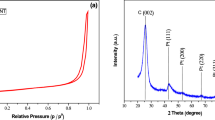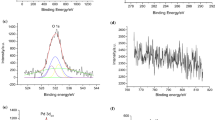Abstract
This work examines the formic acid electrooxidation capabilities of Pd catalysts supported by multiwall carbon nanotubes that were synthesized at varying weight percentages. Advanced surface analysis techniques, namely, X-ray diffraction, X-ray photoelectron spectroscopy (XPS), transmission electron microscopy, scanning electron microscopy with X-ray energy dispersive, and elemental mapping, are used to evaluate the Pd/MWCNT. To achieve the highest specific activity for formic acid electrooxidation on Pd/MWCNT, electrode preparation parameters, namely, catalyst slurry amount, ultrasonication duration of catalyst slurry, and electrode drying time, were optimized by response surface methodology-central composite design. Measurements made using cyclic voltammetry, electrochemical impedance spectroscopy, and chronoamperometry are used to determine the specific activity and stability of formic acid electrooxidation. The optimum values for the catalyst slurry amount, electrode drying time, and ultrasonication duration of catalyst slurry were determined as 1.84 μl, 45 min, and 37.05 min, while under these optimum conditions, the specific activity on Pd/MWCNT was 2.67 mA cm−2 with a deviation of 6.83%. By optimizing the electrode preparation conditions, a conventional Pd/MWCNT catalyst showed higher performance than many bimetallic catalysts. Optimization of electrode preparation parameters is as important as catalyst design and is an inexpensive and facile method to improve electrocatalytic performance.
Graphical Abstract








Similar content being viewed by others
Data availability
Not applicable.
References
Browne MP, Sofer Z, Pumera M (2019) Layered and two dimensional metal oxides for electrochemical energy conversion. Energy Environ Sci 12(1):41–58
Lindorfer J, Rosenfeld DC, Böhm H (2020) Fuel cells: energy conversion technology. In: Future Energy. Elsevier, pp 495–517
Al Arni S, Bosio B, Arato E (2010) Syngas from sugarcane pyrolysis: an experimental study for fuel cell applications. Renew Energy 35(1):29–35
Zhou Y et al (2022) Novel Superaerophobic Anode with fern-shaped Pd nanoarray for high-performance direct formic acid fuel cell. Adv Funct Mater 32(27):2201872
Yin M et al (2012) Tungsten carbide promoted Pd and Pd–Co electrocatalysts for formic acid electrooxidation. J Power Sources 219:106–111
Thijs B, Ronge J, Martens JA (2022) Matching emerging formic acid synthesis processes with application requirements. Green Chem 24(6):2287–2295
Miesse CM et al (2006) Direct formic acid fuel cell portable power system for the operation of a laptop computer. J Power Sources 162(1):532–540
Yu X, Pickup PG (2008) Recent advances in direct formic acid fuel cells (DFAFC). J Power Sources 182(1):124–132
Rejal SZ, Masdar MS, Kamarudin SK (2014) A parametric study of the direct formic acid fuel cell (DFAFC) performance and fuel crossover. Int J Hydrog Energy 39(19):10267–10274
Jeong K-J et al (2007) Fuel crossover in direct formic acid fuel cells. J Power Sources 168(1):119–125
Cappellari PS et al (2019) Catalytic enhancement of formic acid electro-oxidation through surface modifications with gold on supported Pt nanoparticles. Int J Hydrog Energy 44(3):1967–1972
Wang Y, Wang S, Wang X (2009) CeO2 promoted electro-oxidation of formic acid on Pd∕ C nano-electrocatalysts. Electrochemical Solid-State Letters 12(5):B73
Nie R et al (2021) Recent advances in catalytic transfer hydrogenation with formic acid over heterogeneous transition metal catalysts. ACS Catal 11(3):1071–1095
Herron JA et al (2014) Trends in formic acid decomposition on model transition metal surfaces: A density functional theory study. ACS Catal 4(12):4434–4445
Lv Q et al (2018) Pd–PdO interface as active site for HCOOH selective dehydrogenation at ambient condition. J Phys Chem C 122(4):2081–2088
Wang S et al (2017) Catalytic stability study of a Pd-Ni2P/C catalyst for formic acid electrooxidation. ChemElectroChem 4(5):1243–1249
Rezaei H, Jouyban A, Rahimpour E (2022) Development of a new method based on gold nanoparticles for determination of uric acid in urine samples. Spectrochim Acta A Mol Biomol Spectrosc 272:120995
Ananda A et al (2023) RSM-BBD optimization approach for degradation and electrochemical sensing of Evan’s blue dye using green synthesized ZrO2–ZnO nanocomposite. Inorg Nano-Met Chem 1–15. https://doi.org/10.1080/24701556.2023.2165685
Gelis K, Akyurek EF (2021) Entropy generation of different panel radiator types: design of experiments using response surface methodology (RSM). J Build Eng 41:102369
Nawaz A, Kumar P (2022) Optimization of process parameters of Lagerstroemia speciosa seed hull pyrolysis using a combined approach of response surface methodology (RSM) and artificial neural network (ANN) for renewable fuel production. Bioresour Technol Rep 18:101110
Gopinath R et al (2008) Influence of Pd precursor and method of preparation on hydrodechlorination activity of alumina supported palladium catalysts. Catal Lett 120(3):312–319
Ulas B et al (2021) Disentangling the enhanced catalytic activity on Ga modified Ru surfaces for sodium borohydride electrooxidation. Surf Interfaces 23:100999
Kuo C-H et al (2013) The effect of lattice strain on the catalytic properties of Pd nanocrystals. ChemSusChem 6(10):1993–2000
Ulas B, Kivrak H (2020) A Review of Pd based multimetallic anode electrocatalysts for direct formic acid fuel cells. Gen Chem 6(2):190028
Ulas B et al (2023) Hydroxyapatite supported PdxIn100-x as a novel electrocatalyst for high-efficiency glucose electrooxidation. Int J Hydrog Energy 48(18):6798–6810
Wu P et al (2015) Multisource synergistic electrocatalytic oxidation effect of strongly coupled PdM (M = Sn, Pb)/N-doped graphene nanocomposite on small organic molecules. Sci Rep 5(1):14173
Wang X et al (2017) The synergy between atomically dispersed Pd and cerium oxide for enhanced catalytic properties. Nanoscale 9(20):6643–6648
Shen T et al (2022) Engineering Ir atomic configuration for switching the pathway of formic acid electrooxidation reaction. Adv Funct Mater 32(7):2107672
Ulas B, Caglar A, Kivrak H (2019) Determination of optimum Pd: Ni ratio for Pd x Ni 100-x/CNT s formic acid electrooxidation catalysts synthesized via sodium borohydride reduction method. Int J Energy Res 43(8):3436–3445
Bao Y et al (2021) PdNi/N-doped graphene aerogel with over wide potential activity for formic acid electrooxidation. J Energy Chem 59:748–754
Ulas B et al (2019) Carbon monoxide and formic acid electrooxidation study on Au decorated Pd catalysts prepared via microwave assisted polyol method. Fuller Nanotub Carbon Nanostructures 27(7):545–552
Hossain SS et al (2021) Bimetallic Pd-Co nanoparticles supported on nitrogen-doped reduced graphene oxide as efficient electrocatalysts for formic acid electrooxidation. Catalysts 11(8):910
Rajesh D, Mahendiran C, Suresh C (2020) The promotional effect of Ag in Pd-Ag/carbon nanotube-graphene electrocatalysts for alcohol and formic acid oxidation reactions. ChemElectroChem 7(12):2629–2636
Lam BTX et al (2015) Preparation of PdAg and PdAu nanoparticle-loaded carbon black catalysts and their electrocatalytic activity for the glycerol oxidation reaction in alkaline medium. J Power Sources 297:149–157
Zhou J et al (2022) Prediction of planarization property in copper film chemical mechanical polishing via response surface methodology and convolutional neural network. Nano Select 3(3):688–702
Kaya S et al (2022) Optimization of electrode preperation conditions for enhanced glucose electrooxidation on Pt/CNT by response surface methodology. J Electron Mater 51(6):2971–2981
Lee Y et al (2023) Pulsed laser-driven green synthesis of trimetallic AuPtCu nanoalloys for formic acid electro-oxidation in acidic environment. Fuel 332:126164
Tang M et al (2021) Trace Pd modified intermetallic PtBi nanoplates towards efficient formic acid electrocatalysis. J Mater Chem A 9(15):9602–9608
Jin J et al (2023) Effect of MoO3 on Pd nanoparticles for efficient formic acid electrooxidation. Int J Hydrog Energy 48(41):15483–15491
Hanifah MFR et al (2019) One-pot synthesis of efficient reduced graphene oxide supported binary Pt-Pd alloy nanoparticles as superior electro-catalyst and its electro-catalytic performance toward methanol electro-oxidation reaction in direct methanol fuel cell. J Alloys Compd 793:232–246
Bao Y et al (2020) Pd/FeP catalyst engineering via thermal annealing for improved formic acid electrochemical oxidation. Appl Catal B Environ 274:119106
Gharbi O et al (2020) Revisiting cyclic voltammetry and electrochemical impedance spectroscopy analysis for capacitance measurements. Electrochim Acta 343:136109
Digdaya IA et al (2016) Engineering the kinetics and interfacial energetics of Ni/Ni–Mo catalyzed amorphous silicon carbide photocathodes in alkaline media. J Mater Chem A 4(18):6842–6852
Sing KS (1985) Reporting physisorption data for gas/solid systems with special reference to the determination of surface area and porosity (recommendations 1984). Pure Appl Chem 57(4):603–619
Nkosi D et al (2010) Heterogeneous electron transfer kinetics and electrocatalytic behaviour of mixed self-assembled ferrocenes and SWCNT layers. Phys Chem Chem Phys 12(3):604–613
Kaya S et al (2022) Glucose electrooxidation modelling studies on carbon nanotube supported Pd catalyst with response surface methodology and density functional theory. J Phys Chem Solids 168:110810
Geng J et al (2022) Biaxial strained dual-phase palladium-copper bimetal boosts formic acid electrooxidation. Nano Res 15:280–284
Shen Y et al (2020) Pd nanoparticles with twin structures on F-doped graphene for formic acid oxidation. ChemCatChem 12(2):504–509
Hu S et al (2019) Improving the electrochemical oxidation of formic acid by tuning the electronic properties of Pd-based bimetallic nanoparticles. Appl Catal B Environ 254:685–692
Shen T et al (2020) Tailoring the antipoisoning performance of Pd for formic acid electrooxidation via an ordered PdBi intermetallic. ACS Catal 10(17):9977–9985
Zhu F et al (2014) A comparative study of elemental additives (Ni, Co and Ag) on electrocatalytic activity improvement of PdSn-based catalysts for ethanol and formic acid electro-oxidation. Electrochim Acta 148:291–301
Ulas B et al (2018) Composition dependent activity of PdAgNi alloy catalysts for formic acid electrooxidation. J Colloid Interface Sci 532:47–57
Author information
Authors and Affiliations
Contributions
Berdan Ulas: methodology, visualization, conceptualization, data curation, writing—original draft, and writing—review and editing
Corresponding author
Ethics declarations
Ethical approval
This declaration is not applicable.
Conflict of interest
The author declares no competing interests.
Additional information
Publisher’s note
Springer Nature remains neutral with regard to jurisdictional claims in published maps and institutional affiliations.
Supplementary information
ESM 1
(PDF 972 kb)
Rights and permissions
Springer Nature or its licensor (e.g. a society or other partner) holds exclusive rights to this article under a publishing agreement with the author(s) or other rightsholder(s); author self-archiving of the accepted manuscript version of this article is solely governed by the terms of such publishing agreement and applicable law.
About this article
Cite this article
Ulas, B. Optimization of electrode preparation conditions by response surface methodology for improved formic acid electrooxidation on Pd/MWCNT/GCE. Ionics 29, 4603–4616 (2023). https://doi.org/10.1007/s11581-023-05171-z
Received:
Revised:
Accepted:
Published:
Issue Date:
DOI: https://doi.org/10.1007/s11581-023-05171-z




